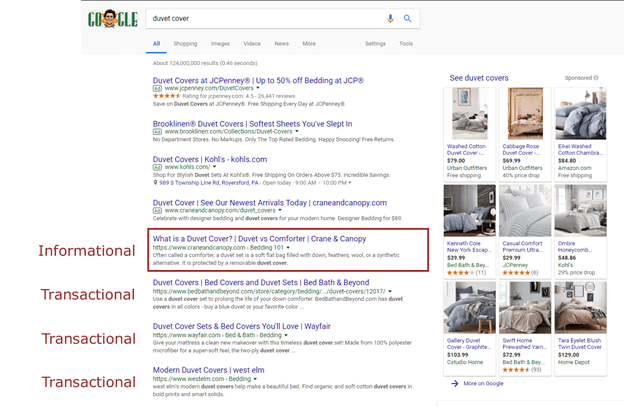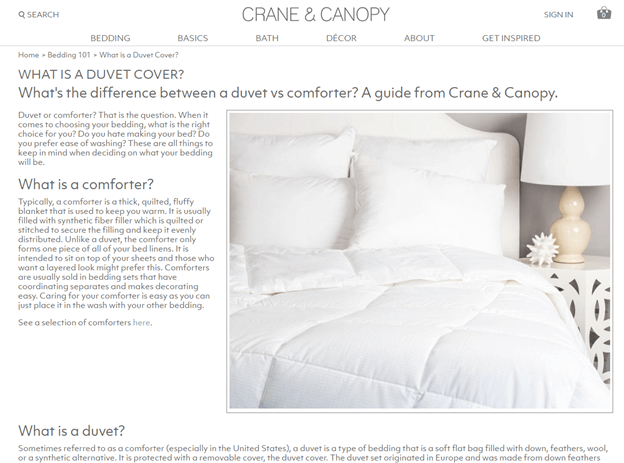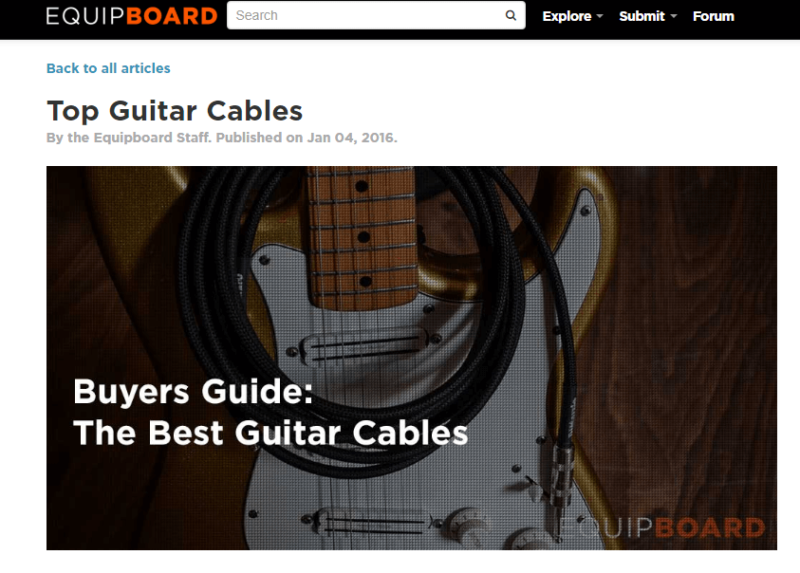How e-commerce can compete for informational queries by optimizing for intent
How do you optimize for search intent? Here's a look at how Google may return informational queries to relevant e-commerce pages and how you can optimize on-page content for 'intent.'
 For as long as search engine optimization specialists (SEOs) have been working with Google, they’ve been thinking about the best ways to optimize for user intent.
For as long as search engine optimization specialists (SEOs) have been working with Google, they’ve been thinking about the best ways to optimize for user intent.
Each search made by a human is an action denoting a need. In our minds, we know what kind of answers we need. The query (keyword) is our best guess toward surfacing that information. Once we click Google’s submit button, we’re expecting Google to impress us.
On the other side, Google understands it’s their burden to essentially read our minds. If they can’t impress us, even when our queries are poor, they’ll lose their market share (and ad revenue).
Some searchers are savvier than others when it comes to their query choices. Some search broadly (which is why they often refine their searches quite routinely). Others enter in long natural-language questions or fragmented but detailed queries. In performing keyword research, the arrangements of keywords run the gamut. A part of understanding your searcher is understanding the style of query they most commonly use.
Drilling into intent
SEOs have divided search types into categories:
- Most popular.
- Navigational.
- Informational.
- Transactional.
I like to use these categorizations as the beginning of classifying intent. I’m not aware of Google using the same classifications, but it certainly seems like they are using something similar today.
Take a query like “electric guitar string gauge.” You might suspect the person entering this into Google is seeking information on the tonal qualities of different guitar string gauges. However, in previous years, Google wasn’t great at matching the right content with the query intent and usually returned an e-commerce page. As a digital marketer trying to drive traffic to an e-commerce page, I would use this lack of sophistication to my advantage and reinforce the category page at the basic keyword level.
But Google has grown. We see Google working harder at matching intent to query. Performing the electric guitar string gauge search today presents a mix of informational and transactional results. The search engine result pages (SERPs), powered by each of Google’s “new-and-improved” algorithms, now show more variety. This makes SEO a bit harder to predict, and it requires more time for study than ever before.
Let’s look at the SERPs
Let’s look at the search result pages for “duvet cover.” Historically, I would have expected to see this keyword treated only as a transactional term, but here, ranking first is an informational landing page from a brand, Crane & Canopy:
According to SEMrush, this page on Crane & Canopy’s website is not as strong as its #2 competitor (Bed Bath & Beyond) by all SEO metrics. Yet, here it is.
Why? I believe it’s because the content is considered a good match to the perceived intent of the search. In Google’s belief, the query “duvet cover” is more about gaining information, to which Crane & Canopy wisely built a page to satisfy the query.
Bed Bath & Beyond stuck with the old school vending-machine style category page. No frills, no expertise, authoritativeness, trustworthiness (EAT) and no innovation.
This isn’t an e-commerce trend. Let’s look at a more B2B-flavored keyword: “customer relationship management” (CRM). In September 2017, this query would pull up the default CRM destination pages for expected player platforms Salesforce, Hubspot and others who made great investments in their SEO and brand development.
But if you look at the search results today, it’s clear Google believes anyone searching for CRM is looking for information about types of CRM technologies rather than looking for specific CRM platforms like Salesforce. Now “what is a CRM” landing pages are dominating the SERPs for the CRM query.
Once you become aware of how Google responds to search terms, you’ll start to pick up on cases like this all the time. This indicates that SERP analysis has to play a bigger role in your day-to-day SEO work.
Why is this happening?
When Hummingbird was released in 2013, we knew Google was getting better at understanding intent. These new search models, plus improvements in personalization and the eventual implementation of AI demonstrate this.
It also falls right in line with Zero Moment of Truth (ZMOT). This principle, by Google, is the research phase. This is where shoppers are seeking information to feed their buying decisions. They put it best in this article by Google:
We saw that people are increasingly making these decisions at the Zero Moment — the precise moment when they have a need, intent or question they want answered online. These questions can be anything from “Which brand of diapers will help my baby sleep through the night?” to “What toothpaste is going to make my smile brighter?” or “What will remove crayon marks from my wood dining table?” A brand that answers these questions at just the right time scores a double win: It helps improve a consumer’s life and stands to gain a competitive advantage over brands that don’t.
If this is the principle Google is using, it explains the lean toward a well-targeted, content-rich piece like we saw with Crate & Canopy versus the Bed Bath & Beyond example.
The content trend in e-commerce
Back in 2010, I wrote an article on SEL called How To SEO A Vending Machine. Granted, it’s a bit old at this point, but I’m still surprised at the amount of bland “vending machines” that still populate the web. If there’s one industry that hasn’t grown at the pace of the internet, it’s e-commerce in general. And this is disappointing, not just from a potential revenue perspective, but also for online shoppers.
Amazon gets it; on its product pages, I find answers to virtually any question I can ask. I believe this is a key reason Amazon continues to dominate results and win loyalty.
I’ve worked on SEO with more than a hundred large e-commerce websites, so I understand the challenges toward progress. There are many hands in the cookie jar and many layers of management involved in making changes on an e-commerce site, which is why many creative experiments stall in development hell.
There are also technology issues for many webstore platforms. They aren’t generally built for content. Instead, they are built to show the thumbnails and flawlessly transfer products into a checkout funnel. (I assume this is why the Crate & Canopy page is on a completely product-free standalone page).
But some are breaking through. Amazon aside, it’s very interesting to see retailers doing more than the standard e-commerce copy at the bottom of the category page. We all know that old tactic by now. That’s copy written for Google and not people. Surely, Google knows that as well. We can do better.
Here are a few callouts from online retail-based websites:
Example 1 – Category-page content. Zappos is an example of a website that straddles old school e-commerce optimization and something a little more interesting. Some of their brand pages put content front and center. When I searched for “what is the quality of Aerosoles shoes,” I was shown this e-commerce page.
In this case, reading about Aerosoles, you are getting answers to some of the possible questions shoppers are asking of Google. If you subscribe to the ZMOT concept, then how perfect is this marriage of content and commerce? Very.
Granted, I would argue that this copy could go a lot further in being valuable to the shopper, but it’s a start. It’s also front and center. In fact, I recently performed a small study which showed users preferred this format over the legacy format.
Example 2 – The affiliates take on the category page. Affiliates have always been at the forefront of SEO. I often see affiliate sites structured in clever e-commerce and content ways.
The blog Equipboard, which I found using a “best guitar cable” query, is a good example.
It contains articles and valuable information with products available to buy. As a guitarist, I can vouch for the integrity of the content. I don’t doubt that SEO is the underpinning of this particular article, but it’s well-written and accurate enough to be considered expert, authoritative and trustworthy (E-A-T).
Granted, it’s driving traffic to another site, but if this site owner wanted to fulfill orders, given the depth and quality of content on the page, it imparts enough trust it could easily do so.
Example 3 – Custom collections. If you can’t create a content hub in your category page design, then maybe you can let your product selections do some of the heavy lifting.
When I searched “Frank Zappa’s guitar gear,” the first e-commerce result was from Reverb.
This was a very clever category page! While there was a huge opportunity to write a Wikipedia-esque entry on Frank’s gear (versus the handful of sentences here), it was still interesting to see a collection that not only answered my question but also gave me an opportunity to make a purchase. That is really nice product segmenting.
Notice the link to non-webstore content. Reverb is not afraid of cross-linking to some really useful content. As a Frank Zappa fan, I spent a good amount of time reading that content, which only endeared me to Reverb even more.
Historically, there has been a fear that allowing a user to leave the products is dangerous. But these days, as the shoppers mature, I believe content only secures the sale.
Easier said than done
I know this can be scary, but take chances with your templates and copy. To boost your attractiveness to informational queries, you need to spend more time on the research and writing phase on your webstore. In e-commerce, we are always looking for a way to scale, as time is money and e-commerce stores have a lot of expenses.
Sadly, I don’t have encouraging news on this front. SEO has gotten much harder and the SEO investment has grown significantly. If you have a low SEO budget in a competitive space and see your competitors optimizing so they rank well, you may want to seriously consider revisiting your expectations.
I still find very low SEO investments among e-commerce companies but wonder about their longevity given the complexities of SEO. If you cannot afford the investment, I recommend you look at where your competitors are lacking and “do better” on your website. You may never be able to afford to boil the ocean, but you can certainly make a few really strong waves here and there. This is where a competitive audit should give you direction.
Conclusion
Could I be wrong? The examples I’ve shown as winners for informational queries are more content-heavy; perhaps it’s not so much about intent, but just better rankings because of content? I don’t believe this is the case. Instead, I believe it’s more of a case of “what you are saying” versus “just saying anything.”
Contributing authors are invited to create content for Search Engine Land and are chosen for their expertise and contribution to the search community. Our contributors work under the oversight of the editorial staff and contributions are checked for quality and relevance to our readers. The opinions they express are their own.
Related stories
New on Search Engine Land




